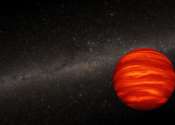New massive eccentric brown dwarf discovered
An international team of astronomers has reported the discovery of a new brown dwarf, which received designation TOI-2490 b. The newfound object is about 74 times more massive than Jupiter and orbits a sun-like star on a ...









